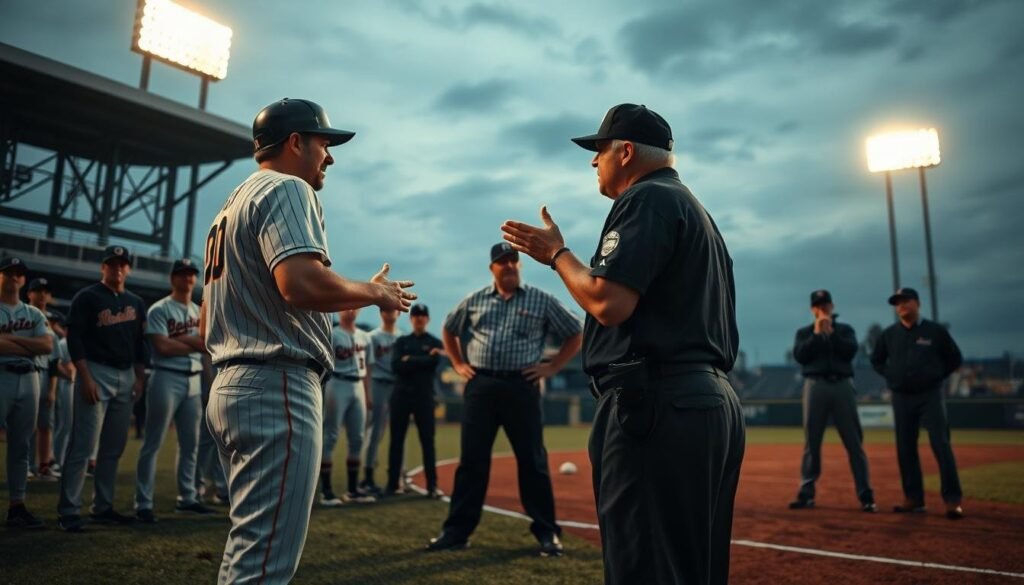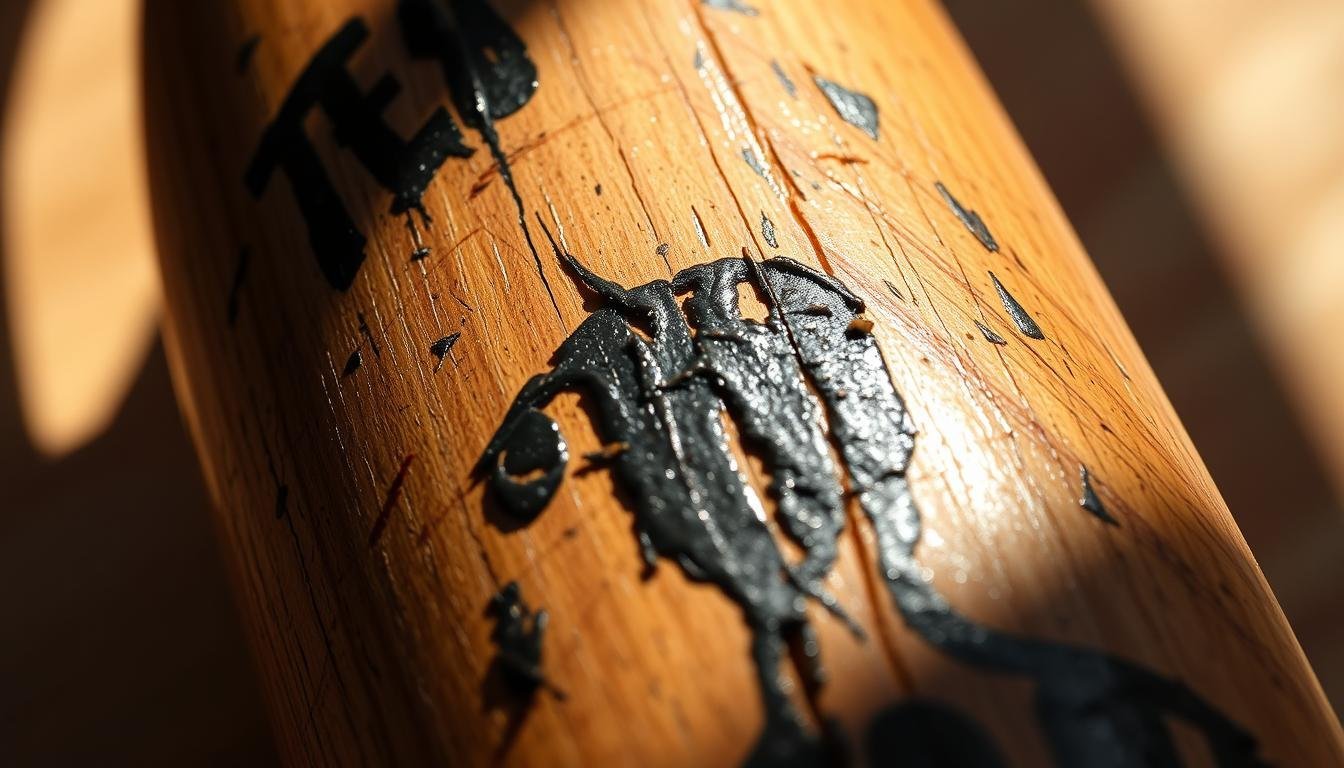Have you ever wondered about the pine tar ban in baseball? For years, players used pine tar to get a better grip on their bats. But, its use sparked a lot of debate, leading to its ban in Major League Baseball.
Pine tar, a sticky substance from pine wood, has been a big part of the game. Yet, its use has caused worries. By looking into its history and famous moments, you’ll understand why it’s banned.
Let’s dive into the world of pine tar baseball and find out the truth about its ban.
Contents
- 1 What is Pine Tar and Its Traditional Role in Baseball
- 2 Why is Pine Tar Banned in Baseball? The Official Rules Explained
- 3 The Historical Context of the Pine Tar Ban
- 4 Famous Pine Tar Incidents and Controversies
- 5 The Science and Strategy Behind Pine Tar Use
- 6 Conclusion: The Future of Pine Tar in America’s Pastime
- 7 FAQ
- 7.1 What is pine tar and why do baseball players use it?
- 7.2 What is the official rule regarding pine tar use in Major League Baseball?
- 7.3 What was the significance of the George Brett pine tar incident in 1983?
- 7.4 Have pitchers also been known to use pine tar?
- 7.5 What are the concerns surrounding pine tar use in baseball?
- 7.6 Is pine tar still used in baseball today?
- 7.7 How does pine tar improve a player’s grip on the bat?
- 7.8 Are there any ongoing debates or discussions about the pine tar ban?
What is Pine Tar and Its Traditional Role in Baseball
In baseball, pine tar helps players grip their bats better. You might wonder what pine tar is and why it’s been used for so long. Pine tar is a sticky, black substance made from pine wood. It’s mainly used for its sticky properties.
Pine tar was applied to the bat handle to make a sticky surface. This helped players keep their grip, especially in hot games. It let them control their swings better and focus on their technique.
Using pine tar was common among baseball players. It helped them control their bats, which is key for good performance. However, rules about pine tar have caused controversy, leading to its ban in some parts of the game.
Knowing how pine tar was used in baseball helps us understand why it’s regulated now. It’s been a big part of the game. The rules about it show the effort to keep the game fair and balanced.
Why is Pine Tar Banned in Baseball? The Official Rules Explained
The ban on pine tar comes from the MLB rulebook. It aims to keep the game fair. If a bat has too much pine tar, the batter is out.
Rule 1.10(c) of the MLB rulebook says no substance can be used to improve the bat’s grip. This rule stops players from using too much pine tar.
Pine tar can change the game’s feel. Using it more than 18 inches up can give a batter a better grip. This might lead to stronger hits.
Umpires check bats during games. If a bat has too much pine tar, the player can be called out. They might face more penalties too.
Knowing these baseball regulations is key for everyone involved. The rules help keep the game fair and true to its spirit.
The Historical Context of the Pine Tar Ban
To understand the MLB pine tar ban, we must look back at baseball’s history. A key moment was the “Pine Tar Incident” in 1983. George Brett’s bat had too much pine tar, causing a big debate over the rules.
This event showed the need for clear pine tar rules. The MLB then made stricter guidelines. The pine tar controversy wasn’t just about the substance but also the unclear rules. The ban came after years of talks and debates. It shows the MLB’s effort to keep the game fair, based on skill, not substances.
Famous Pine Tar Incidents and Controversies
There have been many famous pine tar incidents in baseball that have caused a lot of debate. These incidents involve both pitchers and batters. One of the most famous is with George Brett, a Hall of Fame third baseman.
On July 24, 1983, George Brett hit a home run against the New York Yankees. But it was called off because his bat had too much pine tar. This moment is one of the most remembered in baseball history, showing the big controversy over pine tar.

Pitchers have also used pine tar to get a better grip on the ball, causing more controversy. The grip enhancement allows for better control and movement, but it’s against the rules. Many pitchers have been thrown out of games for this, including some big names.
One example is Michael Pineda, who was thrown out in 2014 for pine tar on his neck. This happened during a very important time in the season. It started a big debate about pitchers using pine tar.
Batter Violations and Outcomes
Batters, like George Brett, have also faced penalties for too much pine tar on their bats. The rule is to stop unfair advantages. But, how it’s applied can be different every time.
Other batters have been penalized for pine tar use too. These cases often lead to arguments about the fairness of the rules and how they’re enforced.
The pine tar controversy in baseball shows how complex the game’s rules can be. These incidents show that the debate over pine tar touches on fairness, tradition, and the game’s spirit.
The Science and Strategy Behind Pine Tar Use
Pine tar is a topic of debate in baseball. It’s loved for its sticky properties, which improve a player’s grip on the bat. This leads to more control and potentially more powerful swings.
The science behind pine tar’s effectiveness is in its viscosity and adhesive qualities. It increases friction between the bat and hands, preventing slippage during swings. This is key in high-pressure situations.
However, pine tar’s use also raises fairness concerns. Baseball regulations aim to keep the game fair for all. Rules dictate how and where pine tar can be applied to the bat.
Players and coaches must consider pine tar’s benefits and the risk of breaking rules. Some use it sparingly to avoid penalties. Others see it as a way to gain an edge.
In summary, pine tar’s role in baseball is complex. Understanding its science and the rules around it helps appreciate the game’s nuances and the decisions made by players and coaches.
Conclusion: The Future of Pine Tar in America’s Pastime
Baseball is always changing, and so is the debate about pine tar. You’re part of a generation watching this ongoing discussion. It’s about the MLB pine tar ban and how it affects the game.
The debate over pine tar is complex. Some say it’s key to the game, while others think it should be banned. This shows how deep the baseball controversy goes. It’s important to understand this to truly appreciate the game.
The future of pine tar in baseball is up in the air. But one thing is sure: the debate will keep going. Fans and players will keep watching as the game evolves. It will be interesting to see how the MLB pine tar ban is handled and if it changes in the future.
FAQ
What is pine tar and why do baseball players use it?
Pine tar is a sticky substance made from pine wood. Baseball players use it to get a better grip on their bat. This helps them control the bat better and hit the ball harder.
What is the official rule regarding pine tar use in Major League Baseball?
MLB has a rule about pine tar. It says no substance can be used to improve the bat grip. If the bat breaks or the handle comes off, the batter is out.
What was the significance of the George Brett pine tar incident in 1983?
The George Brett incident made people realize the need for clear pine tar rules. It led to a review of the rules and stricter enforcement.
Have pitchers also been known to use pine tar?
Yes, pitchers have used pine tar to get a better grip on the ball. This has caused controversy and debate.
What are the concerns surrounding pine tar use in baseball?
People worry that pine tar gives players an unfair advantage. They think it could harm the game’s integrity.
Is pine tar still used in baseball today?
Some players still use pine tar, but it’s closely watched by umpires. Too much use can lead to penalties.
How does pine tar improve a player’s grip on the bat?
Pine tar’s stickiness helps players grip the bat better. This can lead to more control and powerful swings.
Are there any ongoing debates or discussions about the pine tar ban?
Yes, there are debates about the pine tar ban. Some see it as essential to the game. Others think it’s needed to keep the game fair and honest.

Marcellus Stark is an investigative journalist from San Francisco, USA. He writes about global bans, rules, and unusual laws. He shares clear, interesting, and well-researched stories that help readers understand surprising facts worldwide.

